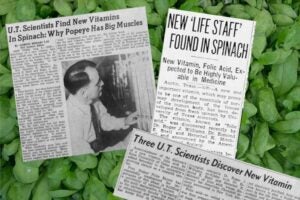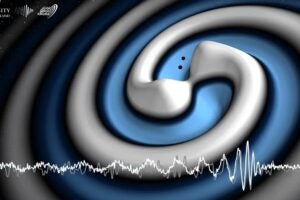AUSTIN, TexasIn a nightmare version of eternal life, cancer cells continue to divide, reproducing themselves endlessly until the patient dies. The growth of tumors is aided by an enzyme called telomerase, which repairs the ends of chromosomes in cancer cells in a way not possible with most normal tissue.
Researchers seeking less painful, more effective, cancer treatments are focusing on ways to block the action of the enzyme telomerase by manipulating the structure of chromosomes in cancer cells. Telomerase is not present in most normal cells, but is associated with the uncontrolled growth of 80 percent to 90 percent of all tumor cells.
Scientists at The University of Texas at Austin have discovered that substances they hope to use as anti-cancer medicines can accelerate the formation of naturally occurring structures that, indeed, appear to disable the rogue enzyme.
Over the past decade, scientists have made major breakthroughs in their knowledge of the intricate structure of chromosomes and of DNA itself. Researchers nationwide have directed their attention to box-like structures, referred to as G-quadruplexes, that are thought to develop at the ends of chromosomes during the life cycles of cancer cells and are considered promising targets for anti-cancer agents.
Evidence from UT Austin researchers that they can use organic compounds to intervene in the process of G-quadruplex formation — and to change the rate of formation of these structures — is a major step forward.
The UT Austin scientists involved in the project include Dr. Laurence Hurley, professor of medicinal chemistry in the College of Pharmacy; Dr. Miguel Salazar, assistant professor of medicinal chemistry; and Dr. Sean M. Kerwin, associate professor of medicinal chemistry.
They are working with scientists at the University of Texas Health Science Center at San Antonio as part of a National Cooperative Drug Discovery Group. This is one of about 20 groups across the United States established by the National Cancer Institute as part of a nationwide effort to accelerate discoveries of anti-cancer drugs. This research project was begun in 1995, funded through a $2.5 million grant from the National Cancer Institute.
Hurley, who holds the George Hitchings Regents Chair in Drug Design, said telomerase has been viewed for several years as a “very promising target for the treatment of cancer. Our work, and the work of other people around the country, continues to point to telomerase as being a selective target.”
Chemotherapy works like a shotgun and stops cancer by killing both cancer cells and normal cells. Scientists are looking for a rifle that will target only cancer cells. The good news with this current line of research is that the small molecular-weight compounds produced in the lab indeed appear to target telomerase by interfering with a structure at found at the ends of chromosomes. They also concentrate themselves in tumors and not in healthy areas of the body. Thus, they would act only against the cancer cells.
“The compounds are much less toxic. They show only slight toxicity in comparison to most chemotherapy drugs,” Hurley said. “The significance of our most recent discovery is that the compounds we are working with appear to trap abnormal, intertwined chromosomal structures in cancer cells and slow the growth of tumors.”
Hurley cautioned that it would be several years before the research has developed to the stage where the compounds could be tested on human subjects.
“The question is, can we use this on animals with tumors, and can we extend the lives of these animals? And the answer appears to be yes. In preliminary experiments this works with mice that have had two types of human tumors implanted in them,” Hurley said.
“Our plans are to get it into a clinical trial on humans within one or two years,” Hurley said. However, Hurley said the next step is to test the compounds on a greater variety of tumors in the lab.
The existence of G-quadruplex DNA in humans has not been proved definitively, but Hurley said there is “an overwhelming body of circumstantial evidence” that the structures do exist, sufficient evidence for scientists to pursue this avenue of research.
Here’s how research experts believe the process works:
Chromosomes are long strings of molecules containing genetic information needed for cells to divide and replicate, that is, to copy themselves over and over again. The ends of chromosomes are capped like shoelaces with structures called telomeres.
In normal cells, bits of information at each end of the chromosomal “shoelace” tend to get lost each time a cell divides, naturally limiting the lifetime of a cell. In cancer cells, there is a mechanism for adding back the lost end of the chromosomes, with telomerase playing an integral role in renewing the ends of the shoelace every time. And, that’s one of the reasons why cancer cells continue to grow, and grow out of control. In contrast, normal cells wear out and die.
The structures at the end of the strands that the scientists are trying to manipulate are extremely complex and they change shape depending on the point in the life cycle of the cell. At a certain point in the life cycle of a cell, the end of a chromosome can, theoretically, change from a single strand into a four-stranded structure. This is G-quadruplex DNA, or G4 DNA.
When this structure folds over on itself, as may naturally occur in the cycle, the action of telomerase is stopped.
The fact that researchers at UT Austin have been able to accelerate the formation and folding of G4 DNA is a major step forward because it means they can manipulate the process.
“What we didn’t know before is that we can start with a single strand of DNA, add the compound and make it fold over,” Hurley said. While other enzymes normally would act to unfold the DNA structure again, Hurley said the compounds both “accelerate the folding and prevent the enzymes that would unfold it again from acting.”
Chromosomes: These are long strings of molecules containing genetic information located in every cell that are needed for cells to divide and replicate. The 23 pairs of human chromosomes are the rod-shaped containers in which DNA is packaged.
DNA: Deoxyribonucleic acid is the chemical and molecular code for all genetic information and determines which cells perform which functions. DNA, is stored in the nucleus of a cell, and shaped like two springs in an old mattress, spiraling around each other in a double helix. The basic structure was discovered in 1953. DNA sequences must be reproduced exactly when cells divide. Each cell contains microscopically tiny strands of DNA six feet in length, and every human being has a unique sequence of DNA. This has been used increasingly by police departments and child support enforcement agencies for identification.
Telomere: Chromosomes, like shoelaces, are capped to keep the ends from fraying by structures called telomeres. Each time a normal cell divides to re-copy itself, bits of information at each end of a chromosome are lost. This creates a natural limit to the life of a cell. Cancer cells, however, are reproduced perfectly each time due to the special actions of an enzyme.
Telomerase: This is an enzyme (or protein acting as a catalyst) that is active in human egg cells, sperm cells, and most cancer cells. In cancer cells, a gene that produces the enzyme telomerase is switched on permanently, giving cancer cells the power to reproduce themselves over and over again.
G-quadruplex DNA: Also called G-4 DNA, this four-dimensional structure is represented as looking something like a box kite. Discovered by scientists in laboratory research in 1962, G4-DNA is believed to form at the ends of chromosomes at certain times during the life cycle of a cell. Scientists believe that when G-4 DNA folds over as the cell’s life cycle continues, telomerase cannot act. New chemical compounds discovered by UT Austin researchers can speed the folding process in tumors in mice and block action of the enzyme telomerase. Like a padlock on a door, the new compounds also prevent the structure from unfolding in a way that would make it again receptive to telomerase.
Scientists discover the basic structure of DNA.
1962
Scientists begin research on complex structures at the ends of chromosomes called G-quadruplex DNA, or G-4 DNA, that they have made in laboratory experiments. Existence of these structures outside the lab has not been determined.
1970s
Telomeres are isolated in laboratory experiments. Geneticists began using the term telomere to refer to the end structure of chromosomes in the 1930s.
1988
Scientists propose that G-4 DNA may, in fact, exist in nature. The G-4 DNA structure is believed to form when a single-stranded DNA structure folds into a four-stranded structure.
1995
Researchers at The University of Texas at Austin College of Pharmacy and The University of Texas Health Science Center in San Antonio win a $2.5 million grant from the National Cancer Institutes to study anti-cancer therapies based on manipulating the structures of genes and chromosomes in cancer cells.
1997
The particular human gene that produces the enzyme telomerase is isolated by a team of researchers working at the University of Texas Southwestern Medical School and Geron Corp. in Menlo Park, Calif. When researchers insert telomerase-producing genes into normal cells, these cells no longer lose bits of chromosome ends when they divide and replicate. One set of researchers hopes this discovery could lead to research into the potentials for rejuvenating body tissues, for example, producing new skin for burn victims. Other scientists hope the discovery will lead to new medicines that can stop tumors from growing by switching off or blocking telomerase.
1998
Scientists are able to extend the lives of cells by using telomerase to repair the ends of chromosomes (telomeres) in healthy, human cells, allowing these cells to continue dividing past the natural limit of about 50 divisions.
May 1999
The journal Cell announces that researchers at the University of North Carolina and Rockefeller University in New York have discovered that chromosomes, or telomeres, are tied off at the ends like tiny lassos. This revelation on the structure of telomeres explains how cells can tell the difference between a broken chromosome, ending in a straight line, and a whole, healthy chromosome, ending in a loop. Presumably, cell death is triggered because telomeres grow shorter each time a cell copies itself. When telomeres finally reach the point where they are just too short to loop, the cell dies.
September 1999
Researchers at the University of Texas at Austin College of Pharmacy and the University of Texas Health Science Center in San Antonio announce that they have used chemical compounds to promote the formation of G-quadruplex DNA. The process has worked successfully in cells of cancer tumors in mice. Scientists hope this discovery will lead to compounds that will be able to disable telomerase, stopping the growth of tumors.



